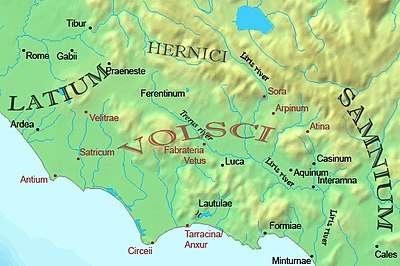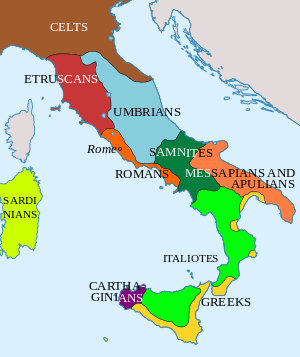Latins
The Latins were originally an Italic tribe in ancient central Italy from Latium. As Roman power and colonization[1] spread Latin culture, Latins came to mean mostly unified Italic people and the Latin-speaking people of Dacia, Iberia, Illyria, and Gaul whose land was settled by Latin colonists (see Latin peoples).
| Part of a series on |
| Indo-European topics |
|---|
 |
|
|
Philology
|
|
Origins |
|
Archaeology Pontic Steppe
Caucasus East Asia Eastern Europe Northern Europe Pontic Steppe Northern/Eastern Steppe Europe
South Asia Steppe Europe Caucasus India |
|
Peoples and societies Indo-Aryans Iranians
East Asia Europe East Asia Europe
Indo-Aryan Iranian
|
|
Religion and mythology
Indo-Aryan Iranian Others Europe
|
|
In the late 15th–16th centuries, a millennium after the fall of the Western Roman Empire, Portugal and Spain began to create world empires. In consequence, by the mid-19th century, the former American colonies of these nations became known as Latin America and this region's inhabitants as Latin Americans.

Antiquity

The Latins were an ancient Italic people of the Latium region in central Italy (Latium Vetus, "Old Latium"), in the 1st millennium BC. Although they lived in independent city-states, they spoke a common language (Latin), held common religious beliefs, and shared a sense of kinship, expressed in the myth that all Latins descend from Latinus. Latinus was worshiped on Mons Albanus (Monte Albano) during an annual festival attended by all Latins, including those from Rome, one of the Latin states. The Latin cities extended common rights of residence and trade to one another.
Rome's territorial ambitions united the rest of the Latins against it in 341 BC, but in the end Rome won in 338 BC. Consequently, some of the Latin states were incorporated within the Roman state, and their inhabitants were given full Roman citizenship. Others became Roman allies and enjoyed certain privileges.
Middle Ages
After the fall of the Western Roman Empire, many Europeans held on to the "Latin" identity, more specifically, in the sense of the Romans, as members of the Empire.
In the Eastern Roman Empire, and the broader Greek-Orthodox world, Latins was a synonym for all people who followed Roman Catholic Christianity.[2] It was generally a negative characterization, especially after the 1054 schism.[2] Latins is still used by the Orthodox church communities, but only in a theological context.
The Holy Roman Empire was founded centuries after the fall of Rome but brandished the name of the Roman people and honoured the king with the title "King of the Romans". Despite this, the Holy Roman Empire was largely a Germanic affair with German kings, although its territory was considerably greater than present-day Germany.
Modern uses
Latin Europe
The term "Latin" is used in reference to European people whose cultures are particularly Roman-derived, generally including the use of Romance languages and the traditional predominance of Western Christianity (especially Roman Catholicism).[3] Strong Roman legal and cultural traditions characterize these nations. Latin Europe is a major subdivision of Europe, along with Germanic Europe and Slavic Europe.
Latin America
Of all world regions, the Americas have been most significantly influenced by Romance-speaking European countries in regards to culture, language, religion, and genetic contribution to the population. The Latin European-influenced region of the Americas came to be called Latin America in the 19th century. The French Emperor Napoleon III is often credited with this naming.[4] The term is usually used to refer to Spanish- and Portuguese-speaking countries, namely Hispanic America and Brazil. The majority of Latin Americans have Latin European ancestry, notably Italian, Spanish, French, Portuguese and Romanian .
Lazio
The Central Italian region, the birthplace of Latin Civilization, still preserves its Latin identity in the modern name Lazio (Ancient Latium).
Latin Valley
A region in Lazio corresponding to the eastern area of ancient Roman Latium (Southern Province of Rome and Province of Frosinone).
See also
- Latin peoples
- Latin Rights
- Latin Valley
- Latin Union
References
- MacKendrick, P. L (1952). "Roman Colonization". Phoenix. 6 (4): 139. doi:10.2307/1086829. JSTOR 1086829.
- George Ostrogorsky, History of the Byzantine State
- Pérez-Perdomo, E.L.M.F.R. (2003-09-09). Legal Culture in the Age of Globalization: Latin America and Latin Europe. Stanford University Press. ISBN 9780804766951. Retrieved 2014-10-10.
- Chasteen, John Charles (2001). Born in Blood and Fire: A Concise History of Latin America. W. W. Norton. p. 156. ISBN 978-0-393-97613-7.